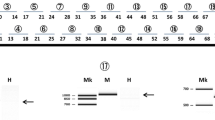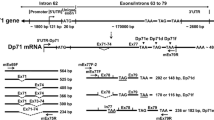Abstract
Duchenne muscular dystrophy (DMD) is a progressive muscle wasting disease caused by mutations in the dystrophin gene. One-third of DMD cases are complicated by mental retardation. Here, we used reverse transcription PCR to analyze the pattern of dystrophin transcripts in neuronal SH-SY5Y cells. Among the three alternative promoters/first exons at the 5′-end, only transcripts containing the brain cortex-specific C1 exon could be amplified. The C-transcript appeared as two products: a major product of the expected size and a minor larger product that contained the cryptic exon 1a between exons C1 and 2. At the 3′-end there was complete exon 78 skipping. Together, these findings indicate that SH-SY5Y cells have neuron-specific characteristics with regard to both promoter activation and alternative splicing. We also revealed partial skipping of exons 9 and 71. Four amplified products were obtained from a fragment covering exons 36–41: a strong expected product, two weak products lacking either exon 37 or exon 38, and a second strong larger product with a 568-bp insertion between exons 40 and 41. The inserted sequence matched the 3′-end of intron 40 perfectly. We concluded that a cryptic splice site was activated in SH-SY5Y cells to create the novel, unusually large, exon 41e (751 bp). In total, we identified seven alternative splicing events in neuronal SH-SY5Y cells, and calculated that 32 dystrophin transcripts could be produced. Our results may provide clues in the analysis of transcriptype–phenotype correlations as regards mental retardation in DMD.




Similar content being viewed by others
References
Agholme L, Nath S, Domert J, Marcusson J, Kagedal K, Hallbeck M (2014) Proteasome inhibition induces stress kinase dependent transport deficits—Implications for Alzheimer’s disease. Mol Cell Neurosci 58:29–39. doi:10.1016/j.mcn.2013.11.001
Ahn AH, Kunkel LM (1993) The structural and functional diversity of dystrophin. Nat Genet 3:283–291. doi:10.1038/ng0493-283
Banihani R, Smile S, Yoon G, Dupuis A, Mosleh M, Snider A, McAdam L (2015) Cognitive and neurobehavioral profile in boys with duchenne muscular dystrophy. J Child Neurol. doi:10.1177/0883073815570154 (in press)
Barry G (2014) Integrating the roles of long and small non-coding RNA in brain function and disease. Mol. Psychiatry 19:410–416. doi:10.1038/mp.2013.196
Biedler JL, Helson L, Spengler BA (1973) Morphology and growth, tumorigenicity, and cytogenetics of human neuroblastoma cells in continuous culture. Cancer Res 33:2643–2652
Bies RD, Phelps SF, Cortez MD, Roberts R, Caskey CT, Chamberlain JS (1992) Human and murine dystrophin mRNA transcripts are differentially expressed during skeletal muscle, heart, and brain development. Nucleic Acids Res 20:1725–1731. doi:10.1093/nar/20.7.1725
Black DL (2003) Mechanisms of alternative pre-messenger RNA splicing. Annu Rev Biochem 72:291–336. doi:10.1146/annurev.biochem.72.121801.161720
Bolisetty MT, Beemon KL (2012) Splicing of internal large exons is defined by novel cis-acting sequence elements. Nucleic Acids Res 40:9244–9254. doi:10.1093/nar/gks652
Bovolenta M, Erriquez D, Valli E, Brioschi S, Scotton C, Neri M, Falzarano MS, Gherardi S, Fabris M, Rimessi P, Gualandi F, Perini G, Ferlini A (2012) The DMD locus harbours multiple long non-coding RNAs which orchestrate and control transcription of muscle dystrophin mRNA isoforms. PLoS One 7:e45328. doi:10.1371/journal.pone.0045328
Castle JC, Zhang C, Shah JK, Kulkarni AV, Kalsotra A, Cooper TA, Johnson JM (2008) Expression of 24,426 human alternative splicing events and predicted cis regulation in 48 tissues and cell lines. Nat Genet 40:1416–1425. doi:10.1038/ng.264
Clark BS, Blackshaw S (2014) Long non-coding RNA-dependent transcriptional regulation in neuronal development and disease. Front Genet 5:164. doi:10.3389/fgene.2014.00164
Cyrulnik SE, Fee RJ, De Vivo DC, Goldstein E, Hinton VJ (2007) Delayed developmental language milestones in children with Duchenne’s muscular dystrophy. J Pediatr 150:474–478. doi:10.1016/j.jpeds.2006.12.045
Daoud F, Angeard N, Demerre B, Martie I, Benyaou R, Leturcq F, Cossee M, Saillour Y, Tuffery S, Urtizberea A, Toutain A, Echenne B, Frischman M, Mayer M, Desguerre I, Estournet B, Reveillere C, Penisson B, Cuisset JM, Kaplan JC, Heron D, Rivier F, Chelly J (2009) Analysis of Dp71 contribution in the severity of mental retardation through comparison of Duchenne and Becker patients differing by mutation consequences on Dp71 expression. Hum Mol Genet 18:3779–3794. doi:10.1093/hmg/ddp320
D’Souza VN, Nguyen TM, Morris GE, Karges W, Pillers DA, Ray PN (1995) A novel dystrophin isoform is required for normal retinal electrophysiology. Hum Mol Genet 4:837–842. doi:10.1093/hmg/4.5.837
Emery AEH (1993) Duchenne muscular dystrophy. Oxford University Press, Oxford
Feener CA, Koenig M, Kunkel LM (1989) Alternative splicing of human dystrophin mRNA generates isoforms at the carboxy terminus. Nature 338:509–511. doi:10.1038/338509a0
Ge Y, Porse BT (2014) The functional consequences of intron retention: alternative splicing coupled to NMD as a regulator of gene expression. BioEssays 36:236–243. doi:10.1002/bies.201300156
Giliberto F, Ferreiro V, Dalamon V, Szijan I (2004) Dystrophin deletions and cognitive impairment in Duchenne/Becker muscular dystrophy. Neurol Res 26:83–87. doi:10.1179/016164104773026589
Gorecki DC, Barnard EA (1995) Specific expression of G-dystrophin (Dp71) in the brain. NeuroReport 6:893–896
Gorecki DC, Monaco AP, Derry JMJ, Walker AP, Barnard EA, Barnard PJ (1992) Expression of four alternative dystrophin transcripts in brain regions regulated by different promoters. Hum Mol Genet 1:505–510. doi:10.1093/hmg/1.7.505
Hawkins JD (1988) A survey on intron and exon lengths. Nucleic Acids Res 16:9893–9908. doi:10.1093/nar/16.21.9893
Holder E, Maeda M, Bies RD (1996) Expression and regulation of the dystrophin purkinje promoter in human skeletal muscle, heart, and brain. Hum Genet 97:232–239. doi:10.1007/BF02265272
Lannaccone M, Giuberti G, De Vivo G, Caraglia M, Gentile V (2013) Identification of a FXIIIA variant in human neuroblastoma cell lines. Int J Biochem Mol Biol 4:102–107
Lidov HG, Selig S, Kunkel LM (1995) Dp140: a novel 140 kDa CNS transcript from the dystrophin locus. Hum Mol Genet 4:329–335. doi:10.1093/hmg/4.3.329
Malueka RG, Takaoka Y, Yagi M, Awano H, Lee T, Dwianingsih EK, Nishida A, Takeshima Y, Matsuo M (2012) Categorization of 77 dystrophin exons into 5 groups by a decision tree using indexes of splicing regulatory factors as decision markers. BMC Genet 13:23. doi:10.1186/1471-2156-13-23
Matlin AJ, Clark F, Smith CW (2005) Understanding alternative splicing: towards a cellular code. Nat Rev Mol Cell Biol 6:386–398. doi:10.1038/nrm1645
Matsuo M, Masumura T, Nishio H, Nakajima T, Kitoh Y, Takumi T, Koga J, Nakamura H (1991) Exon skipping during splicing of dystrophin mRNA precursor due to an intraexon deletion in the dystrophin gene of Duchenne muscular dystrophy Kobe. J Clin Invest 87:2127–2131. doi:10.1172/JCI115244
Mehler MF (2000) Brain dystrophin, neurogenetics and mental retardation. Brain Res Rev 32:277–307. doi:10.1016/S0165-0173(99)00090-9
Mikulak J, Negrini S, Klajn A, D’Alessandro R, Mavilio D, Meldolesi J (2012) Dual REST-dependence of L1CAM: from gene expression to alternative splicing governed by Nova2 in neural cells. J Neurochem 120:699–709. doi:10.1111/j.1471-4159.2011.07626.x
Mironov AA, Fickett JW, Gelfand MS (1999) Frequent alternative splicing of human genes. Genome Res 9:1288–1293
Mount SM (2000) Genomic sequence, splicing, and gene annotation. Am J Hum Genet 67:788–792. doi:10.1086/303098
Muntoni F, Torelli S, Ferlini A (2003) Dystrophin and mutations: one gene, several proteins, multiple phenotypes. Lancet Neurol 2:731–740. doi:10.1016/S1474-4422(03)00585-4
Nilsen TW, Graveley BR (2010) Expansion of the eukaryotic proteome by alternative splicing. Nature 463:457–463. doi:10.1038/nature08909
Nishida A, Minegishi M, Takeuchi A, Niba E, Awano H, Lee T, Iijima K, Takeshima Y, Matsuo M (2015) Tissue and case-specific retention of intron 40 in mature dystrophin mRNA. J Hum Genet. doi:10.1038/jhg.2015.24 (in press)
Oltean S, Bates DO (2013) Hallmarks of alternative splicing in cancer. Oncogene. doi:10.1038/onc.2013.533 (in press)
Pan Q, Shai O, Lee LJ, Frey BJ, Blencowe BJ (2008) Deep surveying of alternative splicing complexity in the human transcriptome by high-throughput sequencing. Nat Genet 40:1413–1415. doi:10.1038/ng.259
Reiss J, Rininsland F (1994) An explanation for the constitutive exon 9 cassette splicing of the DMD gene. Hum Mol Genet 3:295–298. doi:10.1093/hmg/3.2.295
Roberts RG, Barby TF, Manners E, Bobrow M, Bentley DR (1991) Direct detection of dystrophin gene rearrangements by analysis of dystrophin mRNA in peripheral blood lymphocytes. Am J Hum Genet 49:298–310
Roberts RG, Bentley DR, Bobrow M (1993) Infidelity in the structure of ectopic transcripts: a novel exon in lymphocyte dystrophin transcripts. Hum Mutat 2:293–299. doi:10.1002/humu.1380020409
Saint Martin A, Aragon J, Depardon-Benitez F, Sanchez-Trujillo A, Mendoza-Hernandez G, Ceja V, Montanez C (2012) Identification of Dp71e, a new dystrophin with a novel carboxy-terminal end. FEBS J 279:66–77. doi:10.1111/j.1742-4658.2011.08399.x
Shapiro MB, Senapathy P (1987) RNA splice junctions of different classes of eukaryotes: sequence statistics and functional implications in gene expression. Nucleic Acids Res 15:7155–7174. doi:10.1093/nar/15.17.7155
Shkreta L, Bell B, Revil T, Venables JP, Prinos P, Elela SA, Chabot B (2013) Cancer-associated perturbations in alternative pre-messenger RNA splicing. Cancer Treat Res 158:41–94. doi:10.1007/978-3-642-31659-3_3
Sironi M, Cagliani R, Pozzoli U, Bardoni A, Comi GP, Giorda R, Bresolin N (2002) The dystrophin gene is alternatively spliced throughout its coding sequence. FEBS Lett 517:163–166. doi:10.1016/S0014-5793(02)02613-3
Surono A, Takeshima Y, Wibawa T, Pramono ZA, Matsuo M (1997) Six novel transcripts that remove a huge intron ranging from 250 to 800 kb are produced by alternative splicing of the 5′ region of the dystrophin gene in human skeletal muscle. Biochem Biophys Res Commun 239:895–899. doi:10.1006/bbrc.1997.7579
Surono A, Takeshima Y, Wibawa T, Ikezawa M, Nonaka I, Matsuo M (1999) Circular dystrophin RNAs consisting of exons that were skipped by alternative splicing. Hum Mol Genet 8:493–500
Taylor PJ, Betts GA, Maroulis S, Gilissen C, Pedersen RL, Mowat DR, Johnston HM, Buckley MF (2010) Dystrophin gene mutation location and the risk of cognitive impairment in Duchenne muscular dystrophy. PLoS One 5:e8803. doi:10.1371/journal.pone.0008803
Torelli S, Muntoni F (1996) Alternative splicing of dystrophin exon 4 in normal human muscle. Hum Genet 97:521–523
Wang Z, Burge CB (2008) Splicing regulation: from a parts list of regulatory elements to an integrated splicing code. RNA 14:802–813. doi:10.1261/rna.876308
Wang Y, Marino-Enriquez A, Bennett RR, Zhu M, Shen Y, Eilers G, Lee JC, Henze J, Fletcher BS, Gu Z, Fox EA, Antonescu CR, Fletcher CD, Guo X, Raut CP, Demetri GD, van de Rijn M, Ordog T, Kunkel LM, Fletcher JA (2014) Dystrophin is a tumor suppressor in human cancers with myogenic programs. Nat Genet 46:601–606. doi:10.1038/ng.2974
Wein N, Vulin A, Falzarano MS, Szigyarto CA, Maiti B, Findlay A, Heller KN, Uhlen M, Bakthavachalu B, Messina S, Vita G, Passarelli C, Gualandi F, Wilton SD, Rodino-Klapac LR, Yang L, Dunn DM, Schoenberg DR, Weiss RB, Howard MT, Ferlini A, Flanigan KM (2014) Translation from a DMD exon 5 IRES results in a functional dystrophin isoform that attenuates dystrophinopathy in humans and mice. Nat Med. doi:10.1038/nm.3628
Wong JJ, Ritchie W, Ebner OA, Selbach M, Wong JW, Huang Y, Gao D, Pinello N, Gonzalez M, Baidya K, Thoeng A, Khoo TL, Bailey CG, Holst J, Rasko JE (2013) Orchestrated intron retention regulates normal granulocyte differentiation. Cell 154:583–595. doi:10.1016/j.cell.2013.06.052
Xie HR, Hu LS, Li GY (2010) SH-SY5Y human neuroblastoma cell line: in vitro cell model of dopaminergic neurons in Parkinson’s disease. Chin Med J (Engl) 123:1086–1092
Zhang Z, Habara Y, Nishiyama A, Oyazato Y, Yagi M, Takeshima Y, Matsuo M (2007) Identification of seven novel cryptic exons embedded in the dystrophin gene and characterization of 14 cryptic dystrophin exons. J Hum Genet 52:607–617. doi:10.1007/s10038-007-0163-0
Zheng L, Calvo-Garrido J, Hallbeck M, Hultenby K, Marcusson J, Cedazo-Minguez A, Terman A (2013) Intracellular localization of amyloid-beta peptide in SH-SY5Y neuroblastoma cells. J Alzheimers Dis 37:713–733. doi:10.3233/JAD-122455
Acknowledgments
This work was supported in part by a Grant-in-Aid for Scientific Research (B) and a Grant-in-Aid for Exploratory Research from the Japan Society for the Promotion of Science; a Health and Labour Sciences Research Grant for Research on Psychiatric and Neurological Diseases and Mental Health; and a research grant for Nervous and Mental Disorders from the Ministry of Health, Labour, and Welfare.
Author information
Authors and Affiliations
Corresponding author
Ethics declarations
Conflict of interest
The authors declare that they have no conflict of interest.
Rights and permissions
About this article
Cite this article
Nishida, A., Minegishi, M., Takeuchi, A. et al. Neuronal SH-SY5Y cells use the C-dystrophin promoter coupled with exon 78 skipping and display multiple patterns of alternative splicing including two intronic insertion events. Hum Genet 134, 993–1001 (2015). https://doi.org/10.1007/s00439-015-1581-2
Received:
Accepted:
Published:
Issue Date:
DOI: https://doi.org/10.1007/s00439-015-1581-2




